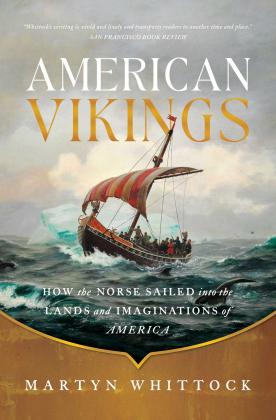A new book by Martyn Whittock, American Vikings: How the Norse Sailed into the Lands and Imaginations of America, tells the story of how notions of a Viking presence in pre-Columbian America have been an enduring part of American culture since the 18th century. Similar to my book, Myths of the Rune Stone: Viking Martyrs and the Birthplace of America, Whittock discusses several factors that fueled this interest, including the translation of the Viking Sagas into English in the mid-19th Century, the mass immigration of Norwegians and Swedes in the late 19th century, and an ongoing effort by white people to assert a European claim to the landscape. After I read the book, I will add some more thoughts to this post. For now, check out Whittock’s essay in Slate.
Science Channel’s “America’s Lost Vikings” Features the Kensington Rune Stone
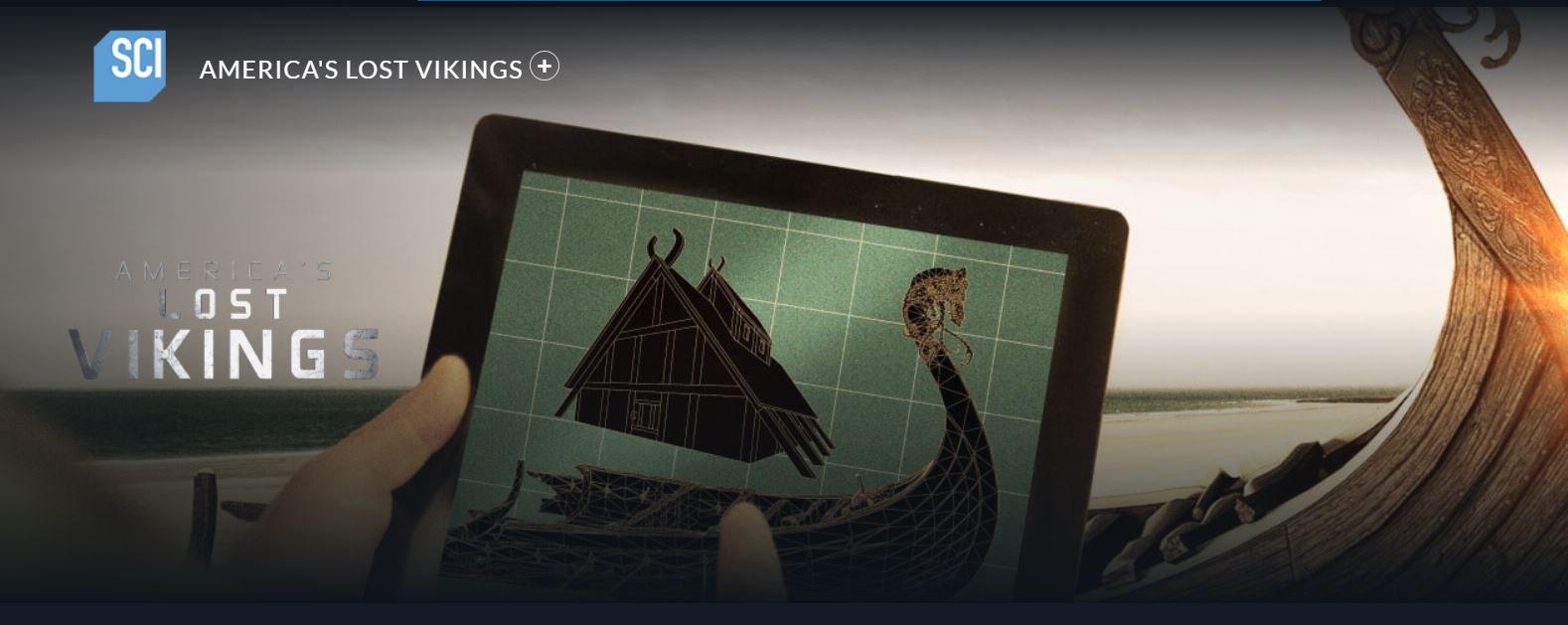
The Science Channel has a new series titled America’s Lost Vikings that premiered on February 17, 2019. I don’t have access to cable TV, so I’ve been unable to view all of the episodes. However, I made it priority to purchase access to Episode 4 “Ghosts of the Great Lakes.” Archaeologists have known since the 1960s that Vikings briefly settled North America around the year 1000 in northeastern Newfoundland, at the site known as L’Anse aux Meadows. However, the question that has obsessed many observers is did they travel further south or west?
Episode 4 follows archaeologists Blue Nelson and Michael Arbuthnot on their journey to Minnesota to research the popular claim that Norse explorers reached what is now Minnesota prior to the explorations of Christopher Columbus. The source of this claim is an artifact known as the Kensington Rune Stone, which was unearthed in a Minnesota farm field owned by Swedish immigrant Olof Ohman in 1898. The stone contains a runic inscription which tells the story of an expedition of Norse explorers that purportedly reached Minnesota in 1362. The inscription claims that ten members of the group were found “red with blood and dead” and many view this rune stone as a type of memorial to their deaths.
Nelson and Arbuthnot traveled to the the Runestone Museum in Alexandria, Minnesota (my hometown, by the way) to get a closer look at the famed artifact. The brief, 42-minute episode tried to address three big questions about rune stone:
- Could the inscription date to 1362?
- Could Norse explorers have reached Minnesota in the fourteenth century?
- Is it possible/likely that Norsemen would have chiseled an inscription of this length?
Using 3-D imaging and an assessment of the soil conditions at the site of discovery, Nelson and Arbuthnot indicated that they would have expected more erosion on the section of the runic inscription on the calcite portion of the stone if it were actually as old as it claimed to be.
Second, Nelson and Arbuthnot attempted to follow (via a small boat specially-crafted for the show) a possible passageway of the Norse explorers to Minnesota. The episode shows the hosts learning basic winter camping survival skills and briefly paddling down a stretch of the St. Louis River, which flows into Lake Superior. Nelson and Arbuthnot conclude that it would have been technically possible for intrepid Viking explorers to travel into what is now Minnesota, but they questioned their willingness to do so. What the episode did not mention is the fact that the St. Louis river is a long way from where the rune stone was unearthed on Ohman’s farm. If Norse explorers had gone up the St. Lawrence River, traversed the Great Lakes, and paddled up a portion of the St. Louis River, they still would have had to walk nearly 200 miles to reach Kensington, Minnesota. The use of a Minnesota map in this episode would have have offered some helpful perspective!
In addition to their short canoe trip, Nelson and Arbuthnot spent some time with rune stone enthusiast and rock carving expert Janey Westin. After some clumsy attempts to chisel runic letters into a slab of greywacke stone, they determined that it would have taken several days to chisel an inscription the length of the one found on the Kensington Stone. They rightly question whether Norse explorers would have taken time required to create a memorial presumably just after their co-travelers had been killed.
Although Nelson quips that the Kensington Rune Stone inscription has “more red flags than a socialist revolution,” the episode still portrays the question of authenticity as open to debate. (See Jason Colavito’s review of this episode.) In reality, the overwhelming majority of the scholarly evidence indicates the runic inscription was chiseled by the Scandinavian immigrants of western Minnesota in the late nineteenth century.
One of the frustrating things about these types of shows is that they often fail to connect on-camera speculations to larger scholarly conversations. One of the most damning pieces of evidence not considered by this Science Channel episode, is that the use of language in the inscription shares similar word choices as a known Swedish dialect in 1880s Sweden. To learn more about these linguistic conclusions, consult Henrik Williams of Uppsala University and the American Association for Runic Studies.
While the scientific and historical evidence surrounding the Kensington Rune Stone is interesting, what I think is far more fascinating is to explore the reasons why so many have believed in the authenticity of the rune stone despite evidence to the contrary. That is the subject of my book Myths of the Rune Stone: Viking Martyrs and the Birthplace of America. The book summary according to the University of Minnesota Press is as follows:
What do our myths say about us? Why do we choose to believe stories that have been disproven? David M. Krueger takes an in-depth look at a legend that held tremendous power in one corner of Minnesota, helping to define both a community’s and a state’s identity for decades.
In 1898, a Swedish immigrant farmer claimed to have discovered a large rock with writing carved into its surface in a field near Kensington, Minnesota. The writing told a North American origin story, predating Christopher Columbus’s exploration, in which Viking missionaries reached what is now Minnesota in 1362 only to be massacred by Indians. The tale’s credibility was quickly challenged and ultimately undermined by experts, but the myth took hold.
Faith in the authenticity of the Kensington Rune Stone was a crucial part of the local Nordic identity. Accepted and proclaimed as truth, the story of the Rune Stone recast Native Americans as villains. The community used the account as the basis for civic celebrations for years, and advocates for the stone continue to promote its validity despite the overwhelming evidence that it was a hoax. Krueger puts this stubborn conviction in context and shows how confidence in the legitimacy of the stone has deep implications for a wide variety of Minnesotans who embraced it, including Scandinavian immigrants, Catholics, small-town boosters, and those who desired to commemorate the white settlers who died in the Dakota War of 1862.
Krueger demonstrates how the resilient belief in the Rune Stone is a form of civil religion, with aspects that defy logic but illustrate how communities characterize themselves. He reveals something unique about America’s preoccupation with divine right and its troubled way of coming to terms with the history of the continent’s first residents. By considering who is included, who is left out, and how heroes and villains are created in the stories we tell about the past, Myths of the Rune Stone offers an enlightening perspective on not just Minnesota but the United States as well.
This past fall, I went on a lecture tour discussing the role that religious and racial anxieties played in the fueling of popular enthusiasm for the Kensington Rune Stone and other purported Viking artifacts in North America. Many white Minnesotans have embraced a popular narrative that the Norsmen were on a journey to spread the Christian faith and claim land for their descendants. Sadly, popular TV shows seem less interested in analyzing the cultural forces fueling pseudo-scientific beliefs and rely instead on keeping mysteries alive.
You can watch one of my lectures here.
Viking Myths & What They Reveal About the (Mis)Shaping of Identity in the Face of the Religious and Racial Other
Here’s the video of my lecture at St. John’s University in Collegeville, Minnesota in Fall 2018.
Fall 2018 Book Tour: Viking Myths & What They Reveal About the (Mis)Shaping of Identity in the Face of the Religious and Racial Other
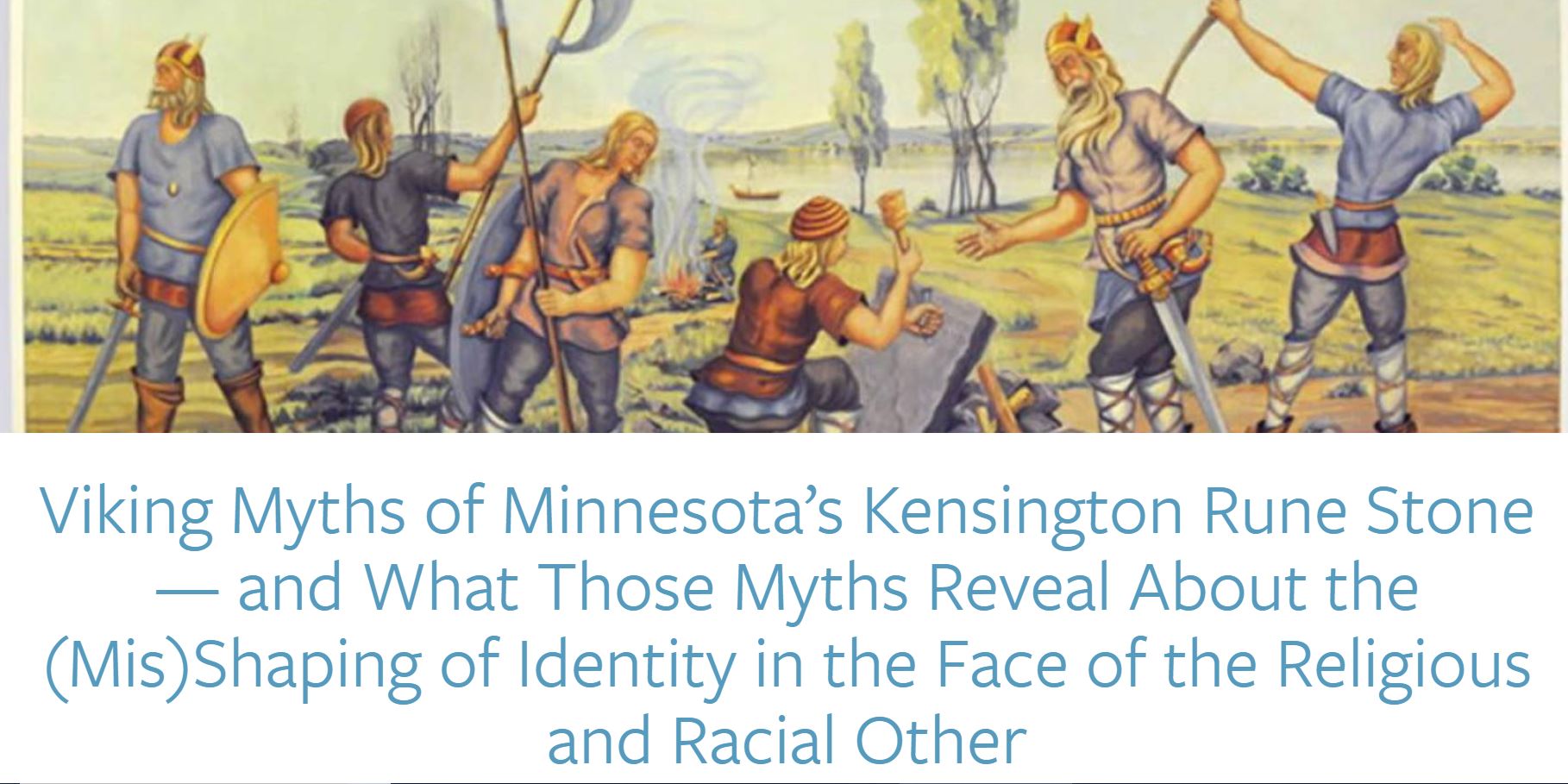
My book, Myths of the Rune Stone: Viking Martyrs and the Birthplace of America, was published by the University of Minnesota Press three years ago. I’m pleased the book is still getting attention and I look forward to several upcoming events.
My first stop will be in Uppsala, SWEDEN for the The 19th Biennial Conference for the International Society for Religion, Literature and Culture held at Uppsala University from September 28-30. The theme of the conference this year is “The Place of Truth” and I’ll be presenting a paper titled “The Sacralization of the Kensington Rune Stone: Constructing a Myth of America’s Birth.” This will be for the Material Religion section. Thanks to S. Brent Plate, the editor of the Material Religion journal for hosting this session.
During the first week of October, I’ll be headed to MINNESOTA for a series of three lectures sponsored by the Jay Phillips Center for Interfaith Learning at the University of St. Thomas. Dr. Hans Gustafson reached out to me several months ago after he had read a copy of Myths of the Rune Stone. The series we come up with is entitled “Viking Myths of Minnesota’s Kensington Rune Stone — and What Those Myths Reveal About the (Mis)Shaping of Identity in the Face of the Religious and Racial Other.”
- October 3 @ 12:15 pm: University of St. Thomas in St. Paul, MN
- October 3 @ 7:00 pm: American Swedish Institute in Minneapolis, MN
- October 4 @ 4:30 pm: St. John’s University in Collegeville, MN
On October 23, I’ll be traveling to Franklin and Marshall College in Lancaster, Pennsylvania to speak to Dr. Mary Ann Levine’s anthropology course entitled “Great Mysteries of the Past.” Dr. Levine’s course explores frauds and hoaxes, the difference between science and pseudoscience, and argument vs. assertion.
Finally, I’ll be traveling to Sarah Lawrence College on Monday, December 10 in New York to participate in an afternoon seminar in conjunction with Professor Irene Elizabeth’s Stroud‘s class “American Religious Mythmaking: The Stories We Tell Ourselves.”
Review of: The Place of Stone: Dighton Rock and the Erasure of America’s Indigenous Past
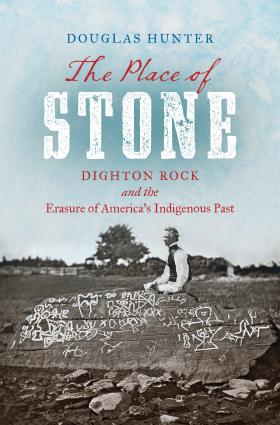 The Place of Stone: Dighton Rock and the Erasure of America’s Indigenous Past. By Douglas Hunter. Chapel Hill: The University of North Carolina Press, 2017.
The Place of Stone: Dighton Rock and the Erasure of America’s Indigenous Past. By Douglas Hunter. Chapel Hill: The University of North Carolina Press, 2017.
This review was recently published in
In the early nineteenth century, Joseph Smith claimed that he unearthed golden plates in a New York hillside that told the story of a Lost Tribe of Israel’s journey to America. In the early twentieth century, rural Minnesotans used a stone with a runic inscription to argue that Norsemen visited the region long before the voyages of Columbus. Even today, the popularity of television shows such as Ancient Aliens and America Unearthed demonstrate that many are still on the look-out for alternative theories about pre-Columbian America. Douglas Hunter’s book,The Place of Stone, uses the history of the Dighton Rock to explain the motivations behind the centuries-long belief that North America was…
View original post 838 more words
Skype Meeting with NDSU Class “Magic and Religion”
Last week, I had the privilege of participating in a Skype conversation with a North Dakota State University class about my book, Myths of the Rune Stone: Viking Martyrs and the Birthplace of America. Professor Alexander Hsu, a PhD Candidate at University of Chicago in the History of Religions, used the book in his course “Magic and Religion.”
Professor Hsu’s students were really terrific, and we had a fascinating discussion. Many students saw the book as a an important historical analysis that offered perspective on contemporary racial justice movements and debates over immigration.
Most of the students were from the region. I will post the syllabus and other details soon.
O. Fritiof Ander Lecture: “American Rune Stone— Monument, Memorial and Myth”
On October 7, 2017, I had the privilege of delivering the annual O. Fritiof Ander Lecture on immigration history. The lecture is sponsored by the Swenson Swedish Immigration Research Center located at Augustana College in Rock Island, Illinois. I was invited by Professor Dag Blanck, the director of the Swenson Center. I have been a fan of Dag’s research on Swedish American identity for many years, but I had the privilege of meeting him at the Society for Advancement of Scandinavian Study conference earlier in 2017.
When Dag gave the introduction before my lecture, he noted that this was the second Ander lecture focused the Kensington Rune Stone. The first was delivered by Professor Henrik Williams from Uppsala University. Henrik is perhaps the world’s leading expert on runic inscriptions. His talk focused on the language of the inscription on the rune stone. His conclusion is that inscription was mostly like produced by residents near Kensington, Minnesota in the late nineteenth century.
The focus of my research is on the reasons that so many have persisted in believing that the Kensington Rune Stone to be an authentic artifact from the fourteenth century, despite evidence to the contrary. My lecture outlines many of the themes in my book, but ended my talk by discussing ways that I think the history of the Kensington Stone is relevant to contemporary discussions about the increasing popularity of fringe history and its relationship to notions of white supremacy.
Runic Scholar and Midwest Historian Visit Philadelphia’s Swedish Museum
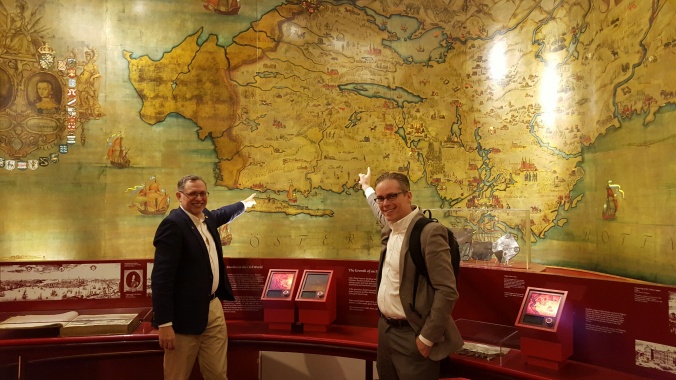
Dr. Williams (on the left) and me at the American Swedish Historical Museum. We are both pointing to the respective regions in Sweden to which we have familial ties. My great-great grandparents came to Minnesota in the 1880s.
As noted in a previous post, I invited Swedish runic scholar Henrik Williams to speak at a special event on November 14, 2016 at the University of Pennsylvania Museum of Archaeology and Anthropology. Dr. Williams is a professor of Scandinavian languages at Uppsala University in Sweden and cooperates with the American Association of Runic Studies (AARS), an organization committed to historically accurate, peer-reviewed, scientific analysis of runes and runic inscriptions. Henrik is also engaged in an educational partnership with the NFL’s Minnesota Vikings. Be sure to visit the team website for a series of articles and a video about accurate portrayals of Viking history.
Earlier in the day, I had the pleasure of escorting Henrik Williams and Loraine Jensen, president of AARS, to the American Swedish Historical Museum. We met with executive director Tracey Beck and got an insider’s tour of the museum with various staff members. After a short fika (Swedish coffee and refreshments), Henrik was put to work analyzing some runic text found on a ceremonial cane at the museum. He was able to determine that the runes were related to a calendar of holidays.
Readers of this blog may be unaware that the Swedes played an important role in the history of Philadelphia. Although the large migration of Swedes to the American Upper Midwest did not occur until the late nineteenth and early twentieth centuries, the Delaware River Valley was colonized by Sweden from 1638 to 1655. Although the colony was short-lived and eventually taken over by the Dutch, and later, the English, the Swedes had a lasting impact on the region. The Gloria Dei ‘Old Swedes’ Church is the oldest surviving church building in Philadelphia. The blue and yellow colors of Philadelphia’s city flag are said to have been chosen to commemorate the city’s Swedish heritage. The American Swedish Historical Museum was founded in 1926 to to preserve and promote Swedish and Swedish-American cultural heritage and traditions in Philadelphia and beyond.
Henrik, Loraine, and I spent much of the afternoon at the museum viewing the various exhibits. Before we departed for the evening’s Kensington Rune Stone lecture at the Penn Museum (to be discussed in a forthcoming blog post), Henrik presented me with a two gifts. The first was a copy of an excellent book called Runes by Martin Findell. It was published by the British Museum and it is an authoritative text on runic inscriptions. The second was a pin from Uppsala University. According to Henrik, the pin makes me an honorary member of the Uppsala University global community. I’m honored!
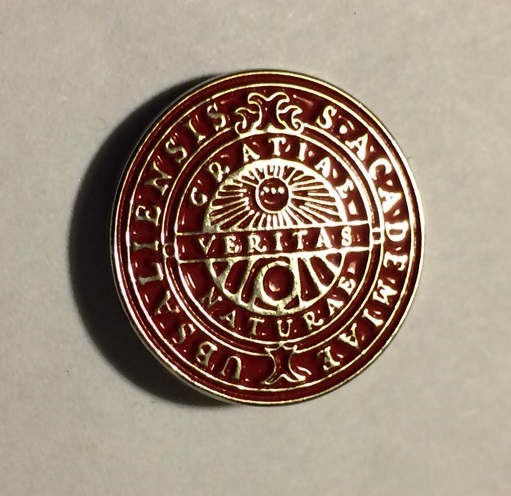
I look forward to returning to the American Swedish Historical Museum in the spring for their annual Viking day held on April 29, 2017 from 12 – 4 pm. I will be giving a lecture on the enduring popularity of Vikings in American culture. I very much enjoyed giving a presentation at last year’s Viking Day on my book Myths of the Rune Stone: Viking Martyrs and the Birthplace of America.
American Runic Tour 2016
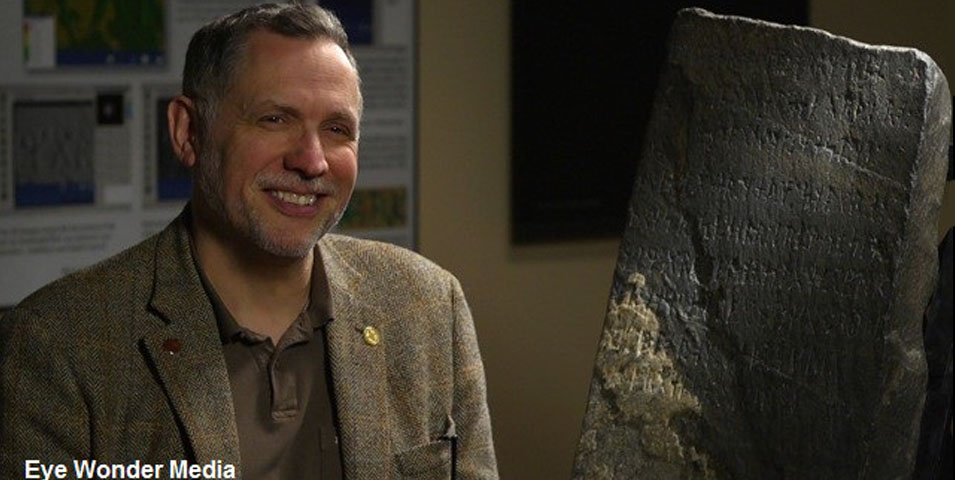
Uppsala University runic scholar Henrik Williams seated next to the Kensingon Rune Stone.
The aim of Myths of the Rune Stone: Viking Martyrs and the Birthplace of America is to tell the story of how the Kensington Rune Stone emerged as sacred, civic totem that embodied the aspirations and anxieties of Minnesotans in the twentieth century. Furthermore, it illuminates the various reasons that Minnesotans have wanted so badly to believe that Vikings visited the American Midwest long before Christopher Columbus reached the “New World.” The question of “is the rune stone real or fake?”is not the most important part of my analysis.
My working assumption has been that the runic inscrption unearthed in a Swedish immigrant’s farm field in 1898 was most likely created in the late nineteenth century. When people press me on the specifics of why I don’t consider it to be an artifact created in the fourteenth century, I refer them to the work of researchers who are better equipped to answer the geological, linguistic, archaeological, and historical questions pertinent to the Kensington Rune Stone. I remind people that I am primarily a 19th and 20th-century historian who specializes in social theory, religion, and American culture. Given the somewhat superficial attention I give to the question of the rune stone’s authenticity in my book, I have listed some additional resources here that will help readers to wrestle with the many scientific questions involved. Among the researchers I have found to be the most persuasive is runic scholar Henrik Williams.
Dr. Williams is a professor of Scandinavian languages at Uppsala University in Sweden and he is also the lead researcher for the American Association of Runic Studies, which is committed to historically accurate, peer-reviewed, scientific analysis of runes and runic inscriptions. The organization also coordinates academic exchanges between Sweden and the United States. In coming weeks, William will be traveling across the U.S. and may be speaking at a location near you (see full itinerary below).
I’m particularly excited that Dr. Williams will be speaking along with me at the Museum of Archaeology and Anthropology at the University of Pennsylvania in Philadelphia, PA on Monday, November 19 at 600 pm. The title of our panel is “Vikings, Pioneers, and Natives: the Kensington Rune Stone and the Contested History of the American Midwest.” Follow the links for the Penn Museum announcement and the Facebook event page. We will be joined by Dr. Ada Kuskowski (Department of History) and Dr. Brian Daniels (Penn Cultural Heritage Center) who are both professors at the University of Pennsylvania. The conversation will be interdisciplinary and will consider how ideas about race, religion, and science play out through the artifact known as the Kensington Rune Stone.
A light reception will follow the event and I’ll be there to sign books as well.
A complete list of the Henrik Williams events in the United States:
October 25, Seattle, WA
Norwegian Heritage Museum, Cracking the Runic Code
October 26, San Francisco, CA
6:00 p.m., Swedish American Hall at 2174 Market Street, San Francisco, CA
Runic Women
October 29, Northfield, MN
Norwegian American Historical Assn (NAHA) Annual Meeting, Saint Olaf College, (private event)
November 1, Saint Paul, MN
Minnesota History Center, Rune Stones American Style
November 3rd,, Alexandria, MN
Celebration Dinner, (private event)
November 5th, Bloomington, MN
Torske Klubben,“Cracking the Runic Code: Runes and Runic Inscriptions in Norway”, (members only event)
November 6th, Minneapolis, MN
Uppsala University Recognition: Minnesota Vikings vs. Detroit Football game
November 8th
Presentation/Discussion with UCO students Medieval Association. “Runes in Sweden and on Gotland” (class participation)
November 9th
“Forbidden Archaeology” with Dr. Andy White, University of South Carolina, Topic: Kensington Rune Stone, (class participation)
November 9th
Presentation/Discussion with UCO students, Historical Research Course, “Runes and North American Runes”, (class participation)
November 9th, Edmond, OK,
Oklahoma, Sons of Norway, (private event)
November 11, Sierra Vista, AZ
Windemere Conference Center, Henrik Williams: Runic Inscriptions in the Mustang Mountains
November 14, Philadelphia, PA
6:00 p.m., Rainey Auditorium, University of Pennsylvania Museum of Archaeology and Anthropology, 3620 South Street
November 17, Washington, DC
Smithsonian Associates, Henrik Williams: Cracking the Runic Code: The Alphabet of Mystery
Kensington Rune Stone Featured on the Travel Channel
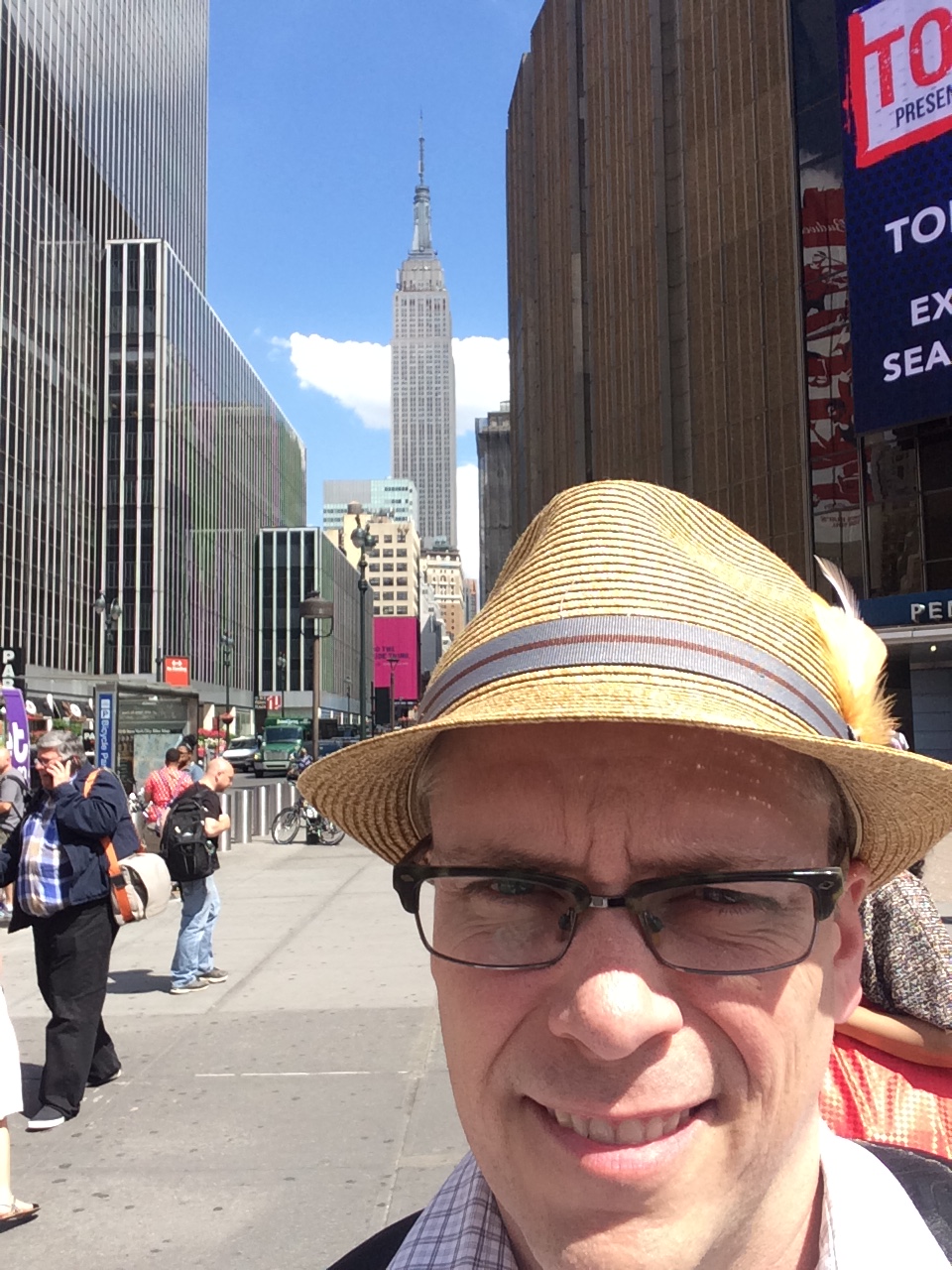
Author and historian David M. Krueger in front of Penn Station on the way home from filming with the Travel Channel in NYC.
Early this summer, I took the train from Philly up to New York City for an afternoon filming session with the Travel Channel’s popular show, Mysteries at the Museum. In case you are not familiar with the show, here is a description:
“Host Don Wildman digs into the world’s greatest institutions to unearth extraordinary relics that reveal incredible secrets from the past. Through compelling interviews, rare archival footage and arresting recreations, “Mysteries at the Museum” illuminates the hidden treasures at the heart of history’s most incredible triumphs, sensational crimes and bizarre encounters.”
The episode to which I contributed is titled “Kensington Runestone, Smile! You’re Being Hijacked and Harriet the Spy” – which premieres Friday, September 30 at 9:00 p.m. ET/PT
In this episode “Don Wildman examines a stone tablet which may hold the key to America’s beginnings, a model plane connected to a hijacking and a revolver that once belonged to the first American woman to lead an armed expedition into war.”
 I wish I could say more more about my contribution to the upcoming show, but I have yet to see it myself! If you enjoy the segment of the Mysteries at the Museum episode, I encourage you to get a copy of my book, Myths of the Rune Stone: Viking Martyrs and the Birthplace of America. It tells the fascinating story of why so many have wanted to believe that Vikings reached what is now Minnesota 140 years before Columbus landed in the so-called “New World.” Feel free to peruse my website to find reviews and other resources related to the topic. Let me know what you think of the episode!
I wish I could say more more about my contribution to the upcoming show, but I have yet to see it myself! If you enjoy the segment of the Mysteries at the Museum episode, I encourage you to get a copy of my book, Myths of the Rune Stone: Viking Martyrs and the Birthplace of America. It tells the fascinating story of why so many have wanted to believe that Vikings reached what is now Minnesota 140 years before Columbus landed in the so-called “New World.” Feel free to peruse my website to find reviews and other resources related to the topic. Let me know what you think of the episode!
–David M. Krueger, PhD
Follow me on Twitter
For a complete list of air times for this Mysteries at the Museum episode, click here.
-
FRIDAYSeptember 309pm | 8c
-
SATURDAYOctober 112am | 11c
-
THURSDAYOctober 1311pm | 10c
-
FRIDAYOctober 142am | 1c
-
SUNDAYOctober 1611am | 10c
-
FRIDAYNovember 187pm | 6c
